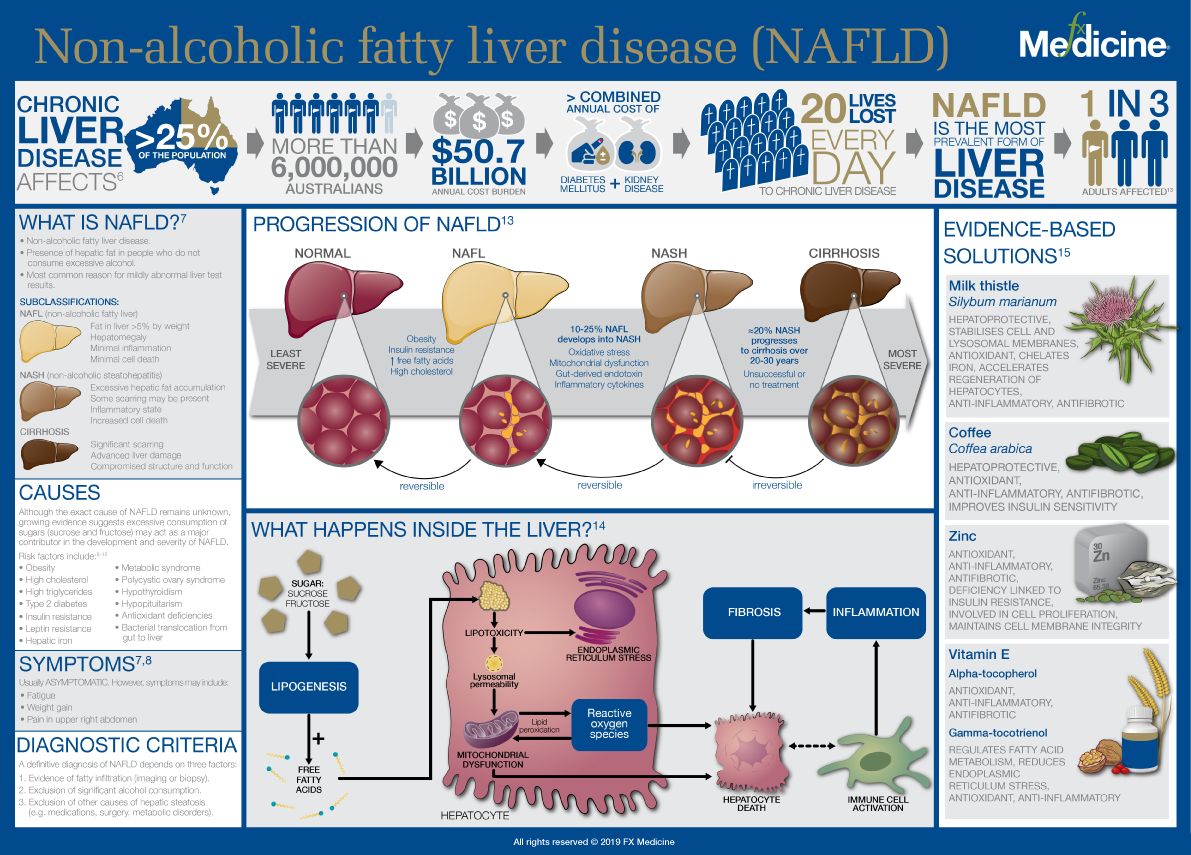
Non-alcoholic fatty liver disease (NAFLD), encompassing both non-alcoholic fatty liver (NAFL) and non-alcoholic steatohepatitis (NASH), is the most common cause of liver disease in Australia. There is increasing evidence for considering NAFLD as part of metabolic syndrome including obesity, hyperinsulinaemia, insulin resistance, hypertriglyceridemia and hypertension. Obesity is a clear risk factor for developing this common condition. The conventional therapeutic approach to NAFLD is based on lifestyle intervention, but there is no consensus on the ideal pharmacological treatment.
Nevertheless, the presence of insulin resistance, increased free fatty acids and peroxidation of lipids in livers observed in those with NAFLD have suggested that therapies that focus on targeted antioxidant and anti-inflammatory actions are a worthwhile consideration. Such therapies have the potential to improve liver function leading to a drop in serum aminotransferase levels and inflammation, along with improvements in liver histology and steatosis.
In particular, several natural agents have been studied to demonstrate such improvements. Trials using milk thistle, coffee, vitamin E and zinc in NAFLD have shown improvements in liver enzyme levels and biochemistry.
In this infographic we review the use of these compounds as viable and effective options for the treatment of this increasingly prevalent condition.
REFERENCES
- Himoto T, Hosomi N, Nakai S, et al. Efficacy of zinc administration in patients with hepatitis C virus-related chronic liver disease. Scand J Gastroenterol 2007;42:1078-1087. [Abstract]
- Shen H, MacDonald R, Bruemmer D, et al. Zinc deficiency alters lipid metabolism in LDL receptor deficient mice treated with rosiglitazone. J Nutr 2007;137:2339-2345. [PDF]
- Toshimitsu K, Matsuura B, Ohkubo I, et al. Dietary habits and nutrient intake in non-alcoholic steatohepatitis. Nutrition 2007;23:46–52. [Abstract]
- Schnabl B, Czech B, Valletta D, et al. Increased expression of zinc finger protein 267 in non-alcoholic fatty liver disease. Int J Clin Exp Pathol 2011;4:661-666. [Full text]
- Liuzzi JP, Lichten LA, Rivera S, et al. Interleukin-6 regulates the zinc transporter Zip14 in liver and contributes to the hypozincemia of the acute-phase response. Proc Natl Acad Sci USA 2005;102:6843-6848. [Full text]
- Rising burden of chronic liver disease - a high price to pay. GESA 2013. Viewed 1 September 2014, www.gesa.org.au/news.asp?id=457
- Information about fatty liver disease. 2nd ed. GESA. Digestive health foundation. 2011. [PDF]
- Nonalcoholic fatty liver disase 2014. Mayo Clinic. Viewed 1st September 2014. http://www.mayoclinic.org/diseases-conditions/nonalcoholic-fatty-liver-d...
- Angulo P, Alba M, Petrovic LM, et al. Leptin, insulin resistance and liver fibrosis in human nonalcoholic fatty liver disease. Hepatol. 2004;41(6):943-949. [Abstract]
- Vigano M, Vergani A, et al. Insulin resistance influences iron metabolism and hepatic steatosis in tye 2 diabetes. Gastroenterology 2000;118(5):986-987. [Abstract]
- Baskol G, Baskol M, Kocer D. Oxidative stress and antioxidant defenses in serum of patients with non-alcoholic steatohepatitis. Clin Biochem 2007;40(11)776-780. [Abstract]
- Miele L, Valenza V, La Torre G, et al. Increased intestinal permeability and tight junction alterations in nonalcoholic fatty liver disease. Hepatology 2009;49(6):1877-1887. [Abstract]
- Iser D, Ryan M. Fatty liver disease - a practical guide for GPs. Aust Fam Physician 2013;42(7):444-447. [Full text]
- Alkhouri N, Feldstein A. The TONIC trial: a step forward in treating pediatric nonalcoholic fatty liver disease. Hepatology 2012;44(4):1292-1295. [Full text]
- Braun L, Cohen M. Herbs and natural supplements: an evidence-based guide, 3rd ed. Sydney: Churchill Livingstone Elsevier, 2010.
This image by FX Medicine is licensed under a Creative Commons Attribution-NonCommercial-NoDerivatives 4.0 International License.
More information about how to share/use the infographics for personal use.
If you interested in using any FX Medicine content for commercial use please contact us.
DISCLAIMER:
The information provided on FX Medicine is for educational and informational purposes only. The information provided on this site is not, nor is it intended to be, a substitute for professional advice or care. Please seek the advice of a qualified health care professional in the event something you have read here raises questions or concerns regarding your health.




